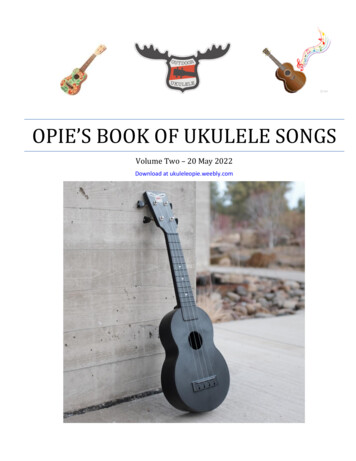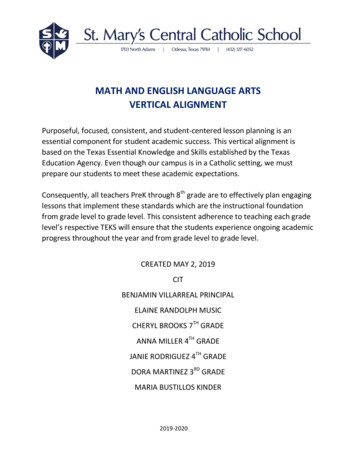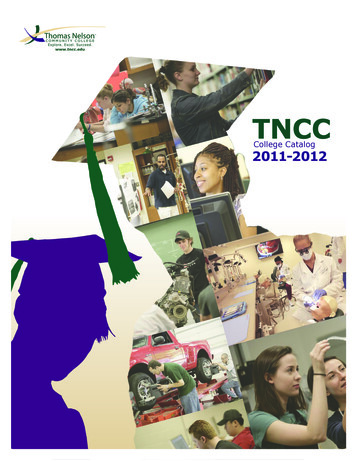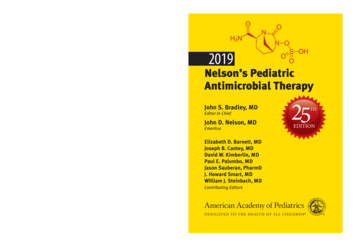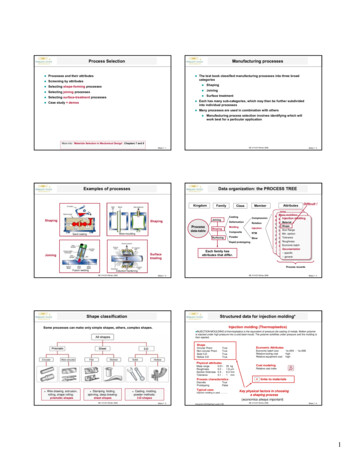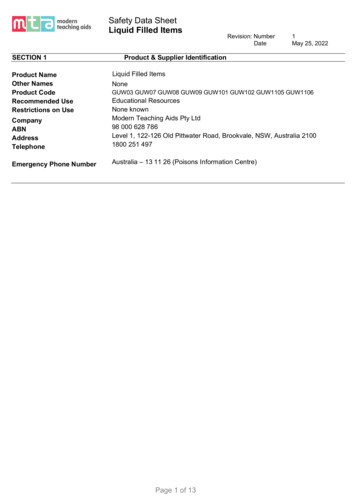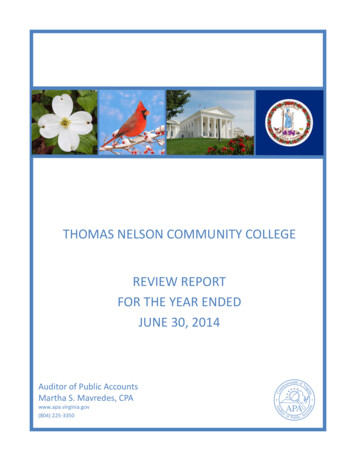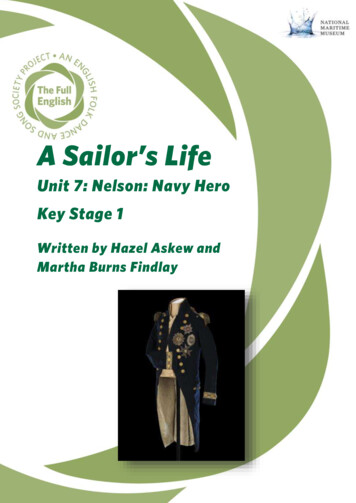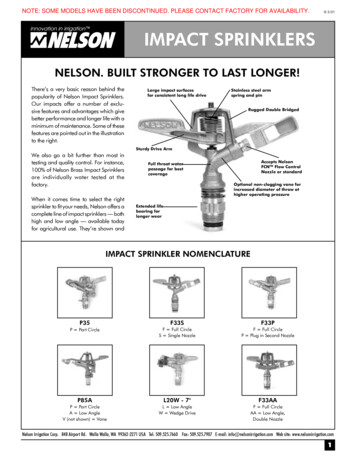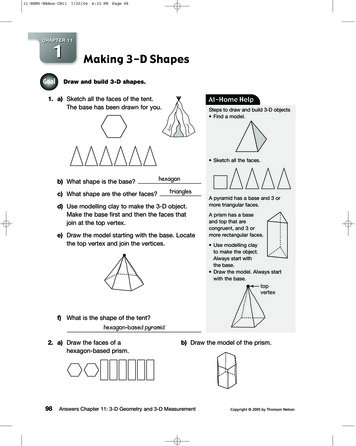
Transcription
11-NEM5-WBAns-CH11 7/20/04 4:32 PM Page 98CHAPTER 111GoalMaking 3-D ShapesDraw and build 3-D shapes.1. a) Sketch all the faces of the tent.The base has been drawn for you.At-Home HelpSteps to draw and build 3-D objects Find a model. Sketch all the faces.b) What shape is the base?hexagonc) What shape are the other faces?trianglesd) Use modelling clay to make the 3-D object.Make the base first and then the faces thatjoin at the top vertex.e) Draw the model starting with the base. Locatethe top vertex and join the vertices.A pyramid has a base and 3 ormore triangular faces.A prism has a baseand top that arecongruent, and 3 ormore rectangular faces. Use modelling clayto make the object.Always start withthe base. Draw the model. Always startwith the base.topvertexf) What is the shape of the tent?hexagon-based pyramid2. a) Draw the faces of ahexagon-based prism.98b) Draw the model of the prism.Answers Chapter 11: 3-D Geometry and 3-D MeasurementCopyright 2005 by Thomson Nelson
11-NEM5-WBAns-CH11 7/20/04 4:32 PM Page 99CHAPTER 112GoalMaking NetsMake nets for 3-D shapes.1.At-Home Helpa) Is this the net of a pyramid or a prism? Explain.It is a prism because there is a top and base thatare congruent, and the other faces are rectangles.When you make nets from3-D objects make sure all the faces are tracedonly once make sure the faces are connectedin the drawing check that the appropriate facesare the same size and shape cut out the net and fold to checkThis net of a pyramid has trianglesattached to the base.A pyramid would have a base but no top, and theother faces would be triangles.b) Name the 3-D object.octagon-based prismc) Draw another net for this object.Suggested answer:This net of a prism has rectanglesall connected. The base and topare congruent, and are attached toopposite sides of the rectangles.d) Trace it on another piece of paper. Cut it outand fold to check.2. a) Name the 3-D object.triangle-based pyramidb) Draw a net for this object.Suggested answer:Copyright 2005 by Thomson NelsonAnswers Chapter 11: 3-D Geometry and 3-D Measurement99
11-NEM5-WBAns-CH11 7/20/04 4:32 PM Page 100CHAPTER 113GoalIdentifying NetsMatch 3-D shapes with their nets.At-Home HelpABECFDGHTo identify the nets of pyramids andprisms and match them with their3-D models, ask yourself: Does the net have a top and abase that are congruent? What shape are the other faceson the net? Does the 3-D model have a topand a base that are congruent? What shape are the other faceson the 3-D model?If the net has a base but no top andthe other faces are triangles, then itis a pyramid.If the net has a top and a base thatare congruent and the other facesare rectangles, then it is a prism.abcdefghB, D, E, and H1. a) Identify the nets of the pyramids.b) Explain how you know they are nets of pyramids.The nets of pyramids have a base but no top, and the other faces are triangles.A, C, F, and G2. a) Identify the nets of the prisms.b) Explain how you know they are nets of prisms.The nets of prisms have a top and a base that are congruent,and the other faces are rectangles.3. Match each pyramid with its net.a and E, c and B, e and D, and g and H4. Match each prism with its net.b and C, d and G, f and F, and h and A100Answers Chapter 11: 3-D Geometry and 3-D MeasurementCopyright 2005 by Thomson Nelson
11-NEM5-WBAns-CH11 7/20/04 4:32 PM Page 101CHAPTER 114GoalCommunicate About Building a ModelWrite clear instructions for building a model from a picture.At-Home HelpWendy wrote instructions to make this cube creature.You will need a whole bunch of cubes.The head is like a T-shape.The arms are sticking out, and each arm is 3 cubes.Each hand is 1 cube, attached to the end of each arm.The body is flat in the middle.The legs are short, with 3 cubes each.1. Go over Wendy’s instructions. Revise and improveeach line if necessary.When you communicate aboutbuilding a model give clear instructions usingmath language show all the steps needed tobuild the model give directions in the correct order give the right amount of detail foreach step do not give information that isnot useful, such as the colourof the cubesCommunication Checklist Did you show all the steps? Did you use the right amountof detail? Did you use math language?Suggested answer:You will need 25 cubes to build the model.The head has 3 cubes all connected in a row.The neck has 2 cubes connected in a row directly below the head.The body has 6 cubes, arranged in 2 rows of 3 cubes each.There are 2 arms. Each arm has 2 cubes that are connected, extending from the top row of the body.There are 2 hands. Each hand has 2 cubes that are connected, attached to the end of each arm.There are 2 feet. Each foot has 2 cubes that are connected, attached below the bottom row of the body.There are decorations on both feet. Each foot has 1 cube on the outer side.2. Check your instructions using the Communication Checklist.Suggested answer:I showed all the steps.I used the right amount of detail.I used math language.3. How can you improve your instructions?Suggested answer:I can improve my instructions by giving the orientation of the cubes in the neck,hands, and feet.Copyright 2005 by Thomson NelsonAnswers Chapter 11: 3-D Geometry and 3-D Measurement101
11-NEM5-WBAns-CH11 7/20/04 4:32 PM Page 102CHAPTER 115GoalMeasuring and Comparing CapacityEstimate, measure, and compare capacities, and determinerelationships among units.1. a) Choose two cups of different sizes in your home.Label them A and B.b) Would you use millilitres or litres to measure thecapacity of each cup? Write your choices in thechart and explain your thinking.Capacity unitCup ACup BSuggested answer: mLI would use millilitres because the cupis small in size.Suggested answer: LI would use litres because the cupcan easily hold a litre.At-Home HelpThe capacity of a container refersto how much the container canhold. Capacity can be measuredusing millilitres or litres.Compare the capacities of twocontainers using one of these ways. Fill each container with water. Thenpour the water into a graduatedpitcher to measure the capacity.The container with the largercapacity can hold the most liquid.2. Use a big spoon or a soup ladle to compare thecapacity of the two cups in Question 1.a) Estimate the number of spoonfuls that will filleach cup. Then measure and record the numberin the table.My estimate:capacity in spoonfulsActual capacityin spoonfulsCup ASuggested answer: 5Suggested answer: 6Cup BSuggested answer: 9Suggested answer: 10b) Which cup has a larger capacity? Explain howyou know. Use a spoon or small cup.Record the number of spoonfulsneeded to fill each container. Thecontainer with the larger capacitycan hold the most spoonfuls. Fill one container with water. Thenpour the water into the othercontainer. If the water overflows,then the first container has alarger capacity. If the water doesnot fill the container, then the firstcontainer has a smaller capacity.(using suggested answer given) Cup B because it canhold 10 spoonfuls while Cup A can hold only 6 spoonfuls.c) Describe another method you could use tocompare the capacity of the two cups.Suggested answer: Fill one of the cups with water. Then pour the water into the other cup.If the water overflows, then the second cup has a smaller capacity. If the water does notfill the cup, then the second cup has a larger capacity.102Answers Chapter 11: 3-D Geometry and 3-D MeasurementCopyright 2005 by Thomson Nelson
11-NEM5-WBAns-CH11 7/20/04 4:32 PM Page 103CHAPTER 116GoalMeasuring and Comparing VolumeEstimate, measure, and compare volumes using cubic centimetres.At-Home HelpVolume is the space taken up byan object.Tanisha’scube creatureTo measure the volume of a3-D object made from centimetrecubes, count the total number ofcubes using one of these two ways. Count the number of cubes ineach section. Then find the totalnumber of cubes for all sections. Look at the object from above.Count the number of cubes ineach column. Then find the totalnumber of cubes for all columns.Nicole’scube creatureBoth creatures were made using centimetrelinking cubes.1. a) For Tanisha’s creature, count and record thenumber of cubes in each body part.The unit for volume is cubiccentimetres (cm3).Body partNumber of cubeshead2164 (2 for each arm)2 (1 for each hand)6 (3 for each leg)2 (1 for each foot)body2 arms2 hands2 legs2 feetb) What is the volume of Tanisha’s creature in cubic centimetres? Show your work.Volume total number of cubes 2 16 4 2 6 2 32 cm32. a) For Nicole’s creature, imagine you are looking at the creature from above.Count and record the number of cubes in each column.010020020010311311111313020020b) What is the volume of Nicole’s creature in cubic centimetres? Show your work.Volume total number of cubes 1 2 2 1 7 3 3 7 2 2 30 cm3Copyright 2005 by Thomson NelsonAnswers Chapter 11: 3-D Geometry and 3-D Measurement103
11-NEM5-WBAns-CH11 7/20/04 4:32 PM Page 104CHAPTER 117GoalRelating Capacity Units to VolumeIdentify the relationship between capacity units and volume units.At-Home HelpThe units of volume and capacityare related.ABC16 cm330 cm331 cm3EF100 cm336 cm3D22 cm31 cm3 1 mLThe volume of a 3-D object can bemeasured using water displacement. Record the volume of water in themeasuring cup at the start. Then put the object under water. Record the volume of water withthe object in the measuring cup. The difference between the 2volumes is equal to the volumeof the object.Models A to F were made using centimetrelinking cubes.1. Find the volume of each model in cubic centimetres.Write your answer below each model.2. Each of the models A to F was put under waterin a measuring cup to measure its volume.For example, the water level wentfrom 400 mL to 430 mL when thisobject was put under water. Sothe volume of the object is 30 mLor 30 0 ml0 ml0 ml0 ml0 ml0 mlbefore 400 mLafter 422 mLbefore 400 mLafter 500 mLbefore 400 mLafter 416 mLbefore 400 mLafter 430 mLbefore 400 mLafter 436 mLbefore 400 mLafter 431 mL22 mL100 mL16 mL30 mLFind the capacity of displaced water in millilitres.Write your answer below each measuring cup.3. Match each model with the correctmeasuring cup.104Answers Chapter 11: 3-D Geometry and 3-D Measurement36 mL31 mLModelABCDEFMeasuring cupcdfabeCopyright 2005 by Thomson Nelson
11-NEM5-WBAns-CH11 7/20/04 4:32 PM Page 105CHAPTER 118GoalMeasuring and Comparing MassEstimate, measure, and compare the masses of objects using appropriate units.At-Home HelpThe mass of most objects we cancarry can be measured in gramsor kilograms.GE1 kg 1000 gCAFBDH1. Circle the unit you would use to measure the mass of the objects in the picture.A g, kgB g, kgC g, kgD g, kgE g, kgF g, kgG g, kgH g, kg2. Match the masses below with the objects in the picture. There may be more thanone possible answer for some masses.a) 7 kgC, D, Gb) 30 gA, Bc) 10 kgCd) 150 gB, Fe) 4 kgD, G, Hf) 35 kgEg) 250 gB, Fh) 3 kgD, G, H3. List three objects you can find in your home that would have a mass in grams.Suggested answer: spoon, hat, and CD4. List three objects you can find in your home that would have a mass in kilograms.Suggested answer: vacuum cleaner, lawn mower, and TVCopyright 2005 by Thomson NelsonAnswers Chapter 11: 3-D Geometry and 3-D Measurement105
11-NEM5-WBAns-CH11 7/20/04 4:32 PM Page 106CHAPTER 119GoalUsing TonnesRelate tonnes to kilograms.At-Home HelpDFAObjects that are big and heavy, suchas trucks, cars, or herds of elephants,are measured in metric tonnes.A tonne is a unit used formeasuring mass.BGECH1 t 1000 kg1 kg 1000 g1. Circle the unit you would use to measure the mass of the animals or objects inthe picture.A kg, tB kg, tC kg, tD kg, tE kg, tF kg, tG kg, tH kg, t2. Match the masses below with the animals or objects in the picture. There may bemore than one possible answer for some masses.a) 6 tF, Hb) 70 tAc) 65 kgGd) 10 tF, He) 45 kgB, Ef) 150 kgCDh) 40 kgB. Eg) 30 t3. List three other objects that would have a mass in tonnes.Suggested answer: garbage truck, fire truck, and ocean liner106Answers Chapter 11: 3-D Geometry and 3-D MeasurementCopyright 2005 by Thomson Nelson
11-NEM5-WBAns-CH11 7/20/04 4:32 PM Page 107CHAPTER 11Test YourselfCircle the correct answer.ModelsABCDEFGNetsabcdefgUse the pictures to answer Questions 1 to 5.1. Which picture is the net of a pyramid?A. net eB. net aC. net cD. net fC. net dD. net cC. model ED. model CC. model GD. model AC. model CD. model E2. Which net matches with model D?A. net bB. net g3. Which model has no parallel edges?A. model BB. model G4. Which model has 4 faces?A. model FB. model D5. Which model matches with net e?A. model AB. model F6. What is the most likely mass for a school backpack?A. 2 gB. 2 tC. 50 kgD. 2 kgC. 150 kgD. 15 kgC. 4500 cm3D. 4 cm37. What is the most likely mass for a piano?A. 150 tB. 150 g8. What is the most likely volume for an apple?A. 450 cm3B. 45 cm39. How much water would likely be displaced if a pencil were put under water?A. 150 mLCopyright 2005 by Thomson NelsonB. 150 LC. 15 LD. 15 mLAnswers Chapter 11: 3-D Geometry and 3-D Measurement107
The container with the larger capacity can hold the most liquid. Use a spoon or small cup. Record the number of spoonfuls needed to fill each container. The container with the larger capacity can hold the most spoonfuls. Fill one container with water. Then pour the water into the other container. If the water overflows, then the first .
